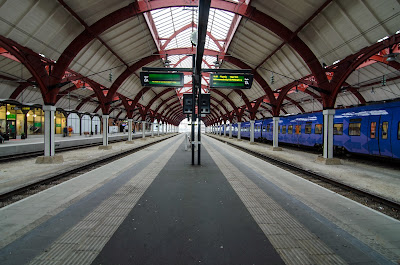 |
| The Malmö Central Station train shed. |
The first railway station in Malmö was opened in 1856, coinciding with the opening of the Malmö - Lund railway. Since the opening the railways station has been rebuilt, extended and modernised several times to cater for changing needs.
A new train shed with four new tracks was built in 1891. This is how it looked at the turn of the century:
 |
| The Malmö railways station train shed in 1900. |
 |
| Another photo, probably shot in 1897. |
In 1924 architect Folke Zettervall designed a new train shed, which is still in use, although most of the train traffic has moved to the new lower level:
In 2000, both local and long-distance trains began running directly to Denmark via the new Öresund Bridge. Malmö became the centre of the new Oresund train regional railway system spanning eastern Denmark and much of southern Sweden, which in 2009 became integrated with local buses and trains in most of its service areas. The trains were, however, forced to reverse direction in Malmö’s terminal station, creating delays for anyone travelling to Denmark from Lund and beyond, and restricting the frequency of service, as each train had to both enter and leave Malmö by the same tracks.
The opening of the City Tunnel in December 2011 made it possible for passenger trains to travel through the station, which had previously been a terminus, and most traffic shifted to the new lower level. All passenger traffic to Denmark now uses the tunnel, and most local trains continue to the new Triangeln and Hyllie stations even if they are not going beyond Malmö. The existing train shed was, however, renovated at the same time, to accommodate occasional long-distance trains including some services to Stockholm and the night express to Berlin, but several tracks were removed to make room for an extended bus terminal.
(Source: Wikipedia)
This is how the Malmö Central Station train shed looks today:
 |
| The old train shed is nowadays mostly used by long-distance trains. |
 |
| In one of the old halls there are now a number of restaurants and coffee shops. |
 |
| Another image of the restaurant hall. |
No comments:
Post a Comment